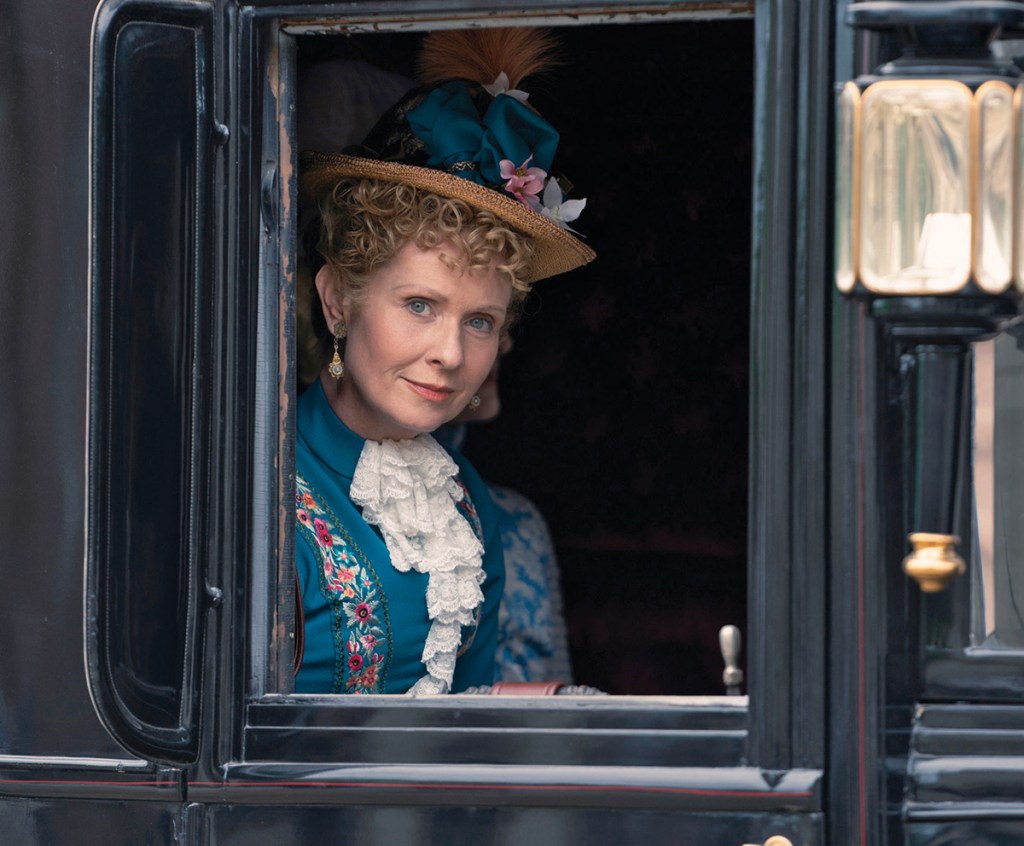In 1984, Cynthia Nixon made Broadway history by appearing in two productions at the same time. A recent graduate of Hunter College High School in New York, Nixon starred in two concurrent plays, “Hurlyburly” and “The Real Thing,” each directed by legendary director Mike Nichols. For three months, the teenager bounced between theaters, inserting a single scene from “The Real Thing” between the two acts of “Hurlyburly.”
Forty years later, the actor and activist’s career has come full circle. Nixon is a series regular on two hit and much-talked about shows: “And Just Like That,” the sequel to “Sex and the City” in which she reprises the iconic role of Miranda Hobbes, and “The Gilded Age,” the Julian Fellowes period drama in which Nixon plays the sweet and open-hearted Ada Brook. This year, for the first time, the series will film their next seasons simultaneously.
Speaking from his New York apartment, Nixon seemed admirably unfazed. “Once the summer starts to heat up, it might get crazy, but for now, it’s OK,” she says, her two Emmy Awards perched on the shelf behind her. “I mean, knock on wood. So far, so good.” Nixon came to our conversation after trying on a seven-hour costume for “And Just Like That,” which began table reading the week before. The filming of “The Gilded Age” won’t start until July, but there’s enough overlap that both sides are actively discussing his schedule “I think the plan is to try to do a week here, a week there, so it doesn’t. “It’s not just about ricocheting on a daily basis,” she reports – although experience has shown that Nixon can ricochet if necessary.
Even before this logistical challenge, Miranda and Ada were already a showcase of Nixon’s adaptive range. For an audience accustomed to the caustic, no-nonsense Miranda that Nixon has inhabited for more than a quarter century, Ada’s wide-eyed romanticism creates a stark contrast. Then again, Miranda herself has changed dramatically over the years, leaving her job in corporate law to pursue legal defense full-time and exploring her sexuality through a torrid affair that ended her marriage and now concluded with non-binary comedian Che Diaz (Sara Ramírez). Of all the returning characters, it’s Miranda who most embodies the progressive bent that distinguishes “And Just Like That” from its predecessor, expanding the show’s worldview beyond the largely white, straight, well endowed with the original.

Dan Doperalski for Variety
It’s no coincidence: Both of these changes bring Miranda closer to Nixon, who met his current wife, Christine Marinoni, while campaigning for funding for New York City’s public schools. Nixon has since run for governor of New York State (in 2018) and recently came out openly in favor of a permanent ceasefire in Gaza, beginning a two-day hunger strike in last November to raise awareness of a potential famine.
“I look a lot more like (Miranda) as I get older, and she looks a lot more like me,” Nixon observes. “That’s not what I was arguing for, but smart writers, especially on long-term projects that continue and evolve, try to put as much of the real person as possible into that character, because that’s the one of the things that makes television, film or theater so powerful – when the person playing the role has a personal connection.
During our interview, she wears a T-shirt urging studios to pay writers, cast, crew “and anyone else who brings you all the money,” a visual reminder of the industry’s work stoppages. last year.
“When you write a character for so long for a specific actress, at some point it’s just sewing,” says Michael Patrick King, showrunner of “Sex and the City” and “And Just Like That.” “You’re just cutting it for them. So when I look at who Cynthia is, she’s incredibly passionate. She cares. And I put that into the role.
Ada also carries elements of Nixon’s social conscience, a nerve of connective tissue between two very different women. “The Gilded Age” takes place at a historical inflection point, when the new fortunes of industrial robber barons threatened to upend the hierarchy of wealthy Manhattan society. Ada is more curious and open to these changes than her older sister Agnes (Christine Baranski), a steely widow allergic to change. Unlike Agnes, Ada doesn’t scoff at the idea of their niece Marian (Louisa Jacobson) taking a paid job as an art teacher, nor does she serve – gasp! — soup for lunch for their new rector, Luke (Robert Sean Leonard). By 19th century standards, she is decidedly avant-garde.
“Cynthia has a civic responsibility. She takes society seriously. She takes her role seriously,” says Fellowes. “It allows her to think about the characters she plays, giving them a certain context – moral, political – which adds to their depth.”
Back when Nixon was doing double duty on Broadway, Baranski was his co-star in “The Real Thing,” although the two actors played mother and daughter rather than sisters. “She always had this extraordinary spirit,” Baranski says. “She has a bubbly quality to her acting and personality that I think is one of her strong qualities. She had it when she was a student at Barnard. And all these years later, I’m working with her, and she’s kept that.
The reunion means that a busy schedule isn’t the only aspect of Nixon’s current job that’s reminiscent of his early career. Leonard is also a long-time colleague; He and Nixon met as teenagers at the New York Theater Workshop and have been friends ever since.

Cynthia Nixon in “The Golden Age”
Barbara Nitke/HBO
“When there’s someone that you already love and admire and feel so comfortable with, it just allows you to jump off that cliff knowing that they’ll catch up with you,” she says. With Baranski, that meant building a convincingly lived dynamic with all the ingrained tics and petty squabbles of a marriage. With Leonard, that meant creating an on-screen relationship that progresses from flirtation to real marriage to illness and heartbreak in just a few episodes. It’s a compressed arc that could, in less experienced hands, turn into a soap opera. But Nixon’s performance reveals several new sides of Ada, a person with privileged but limited life experience, accustomed to living in her sister’s shadow.
“It would obviously be wonderful for someone who has always wanted to find love and doesn’t need to find it at this old age,” Nixon says. “But I think it was especially sweet and precious for Ada, because she’s such a relational person. She is a domestic person and is very interested in her relationships, whether it is her sister, her relatives, her friends or the people who work in her house. In creating the character, Nixon was inspired by her own godmother, who never married but surrounded herself with young people. “(She was) a person who gave you so much confidence in yourself. No matter how old you were, she never tired of hearing about you.
Ada has this experience, albeit briefly. Although her loss carries unusual weight in a series as pleasantly low-stakes as “The Gilded Age” can be, Ada always reads as warm and optimistic, never bitter or defeated.
“She’s a very witty actress and has wonderful comedic timing,” Fellowes says. “So even though Ada may have been downtrodden at times, you’re always happy to see her back on screen.”
In addition, Luke’s death leads to a surprising reversal of roles: with his inheritance and Agnes’ son being cheated out of the family fortune, it is now Ada who holds the household purse strings, putting sets up a seismic realignment in Season 3. “Cynthia and I were laughing imagining Agnes standing in her room while Ada, who is so bohemian, invites all the stray cats and single mothers into the house.” , said Baranski.
Miranda also faces new frontiers in the upcoming season of “And Just Like That.” After divorcing Steve (David Eigenberg) and breaking up with Che, Miranda is truly single for the first time in decades – and with a greater number of post-heterosexual suitors than ever before. An alliance with an audiobook narrator played by Miriam Shor in Season 2 served as a preview of this new normal. “I feel like our show always works better when people are dating,” Nixon admits. She now frequently texts her friends with Ramírez, whose polarizing role has led to some of the show’s most memorable moments. “They created such an incredible character – such a controversial character, but such an incredible character,” Nixon says. “I think they felt, and so did Michael Patrick, that this character had come into its own. They came in and shook it all up, and then the arc was over.

Dan Doperalski for Variety
Despite her unusually busy schedule, Nixon continues to balance her television acting work with other projects. She recently starred in her first play in seven years and made her TV directing debut with Season 2 of “And Just Like That.” Nixon also continued to speak out on Gaza, despite the public and even professional backlash that other critics of the war within the entertainment industry received. “I try to be careful and say that I am very aware of the immense pain and suffering on all sides,” Nixon said. “But I don’t want to live in a world where I can’t say that the killing of unarmed civilians, 70 percent of whom are women and children, if I can’t say it’s not acceptable, I don’t don’t want to live in a world where I can’t say it’s not acceptable, I don’t want to I don’t know what kind of world I live in.
Nixon also reflects on how his lead roles complement each other. “And Just Like That” features subplots about penis pumps and your teenager having sex; “The Gilded Age” is set in a cramped society where hand-holding is the step before marriage. But both, she points out, are worlds dominated by the inner lives and professional concerns of women, many of whom have reached middle age.
“I think the main difference is the incredible constraint of ‘The Gilded Age’ and the freedom of 21st century women in ‘And Just Like That,'” she observes. But that doesn’t mean that one story has more or less resonance than the other: “What’s interesting is that when you’re constrained and constrained and there are so many rules to follow, sometimes very small things can seem huge. »
Miranda may have more options than Ada, but Nixon offers both the same intensity of feeling.